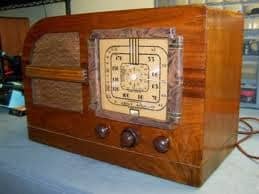Radio in the 1920s
By Karen Osburn, Archivist

How many of you have heard of The Acousticon Hour, The Clicquot Club Eskimos, The Goldbergs, The High-Jinkers, Laundryland Lyrics or Sam ‘n’ Henry? I imagine if I asked how many of you recognized Amos and Andy, Fibber Magee and Molly, The Shadow, The Green Hornet or The Jack Benny Show many more of you would instantly make a connection. The first group was radio shows that debuted in the 1920s while the second group included shows that aired on the radio later in the 1930s, 1940s, and 1950s. Of course most of us weren’t born in the 1920s, or were so young that we can’t recall those names, but these shows were the forerunners to the sit-coms, dramas and variety shows that we do remember from the second half of the 20th Century, both on radio and television.
Let’s take a brief look at radio in the 1920s and expand our “horizons” a bit. Radio historians generally agree that broadcasting for the public began in 1920 with a broadcast on station KDKA out of Pittsburg, PA. However, very few folks heard the broadcast because few radio receivers were privately owned. After word of that original broadcast spread, people overwhelmed radio manufacturers standing line for hours to fill out order forms because the manufacturers had run out of radio receivers. Between 1923 and 1930, fully 60% of American families purchased radios and gathered around the new device to listen to nightly entertainment broadcasts.
The more folks purchased radios, the more radio stations were needed to satisfy the public. While KDKA was not the only station in 1920, it remains the standard by which others were judged. In just two years, 600 stations were up and operating nation-wide.
In 1921 KYW, Chicago’s first radio station, was begun by Westinghouse Electric and Manufacturing. KYW specialized in playing exclusively opera six days a week. They decided to diversify programing when the opera season ended and began offering broadcasts of sports events, lectures, news and weather reports, political commentary and popular and classical music among other things. A radio station like KYW had the ability to enhance a feeling of community among diverse groups living within the listening area. Each group had the choice to listen to broadcasts that appealed to their interests and needs.
Confusion arose with radio’s popularity. The rapid growth of listeners and programs had created an atmosphere with little or no control over the airwaves. This led to a bit of chaos as time slots for programs often overlapped and interfered with shows. A listener might be listening to one program only to have a different show interrupt it.
The government hesitated to regulate the airwaves, while stations, listeners, and broadcast companies all wanted the intervention to sort out the mess. Eventually the government set up the Federal Radio Commission (1926) later organized with the Radio Act of 1927. This act became the Communications Act after television became popular. Eventually, the Federal Government ceased to doubt their right to regulate communications.
Another interesting point is that the listening public, the government, and the start-up radio corporations viewed broadcasting as a public service and seldom as a vehicle for profit. Manufacturers of radio receivers realized a financial gain, but announcers, deejays, and stations worked on a non-profit basis. Once advertising was introduced later in the 1920s, the public service model changed to one of private gain.
One of the shows that made radio so popular was Amos ‘n’ Andy. It was so popular that by 1930 that NBC ordered its affiliates not to interrupt the broadcast unless it was a matter of national importance. At the peak of popularity, many movie theaters advertised that they would stop their films for the Amos ‘n’ Andy show (15 minutes long at the time).
Amos ‘n’ Andy was created by Freeman Gosden and Charles Correll and started out as a program called Sam “n” Henry, which debuted on WGN in Chicago and aired from 1926-1928. It was a ten-minute comedy and is often considered the first situation comedy. The story line revolved around two African-American men from rural Alabama moving to Chicago and overcoming the problems associated with moving to a new area such as food, shelter, and making money. Correll and Gosden produced 586 episodes and supplied the voices for all the characters. They left WGN after their proposal was turned down to record Sam ‘n’ Henry on phonograph records and distribute it to other radio stations to be played on the air.

In March 1928, Correll and Gosden brought their new characters, Amos ‘n’ Andy, to the airwaves on rival Chicago station WMAQ. The plot line and characters closely resembled Sam Smith and Henry Johnson and the show ran as a nightly serial until 1943 (in 1943 it was changed to a 30 minute weekly). Gosden and Correll portrayed all the male roles and performed over 170 different voice characterizations in the first decade of the show. Amos ‘n’ Andy was the first radio show to be syndicated in the United States.
When I wrote this blog I looked in the 1920s city directories of Geneva for a local radio station and didn’t find one, but there were several businesses selling radios in the city so I am sure there were residents here enjoying some of the programs I have mentioned. Well over ten years ago I heard some old time radio programs broadcast on WHAM out of Rochester and became very interested in the shows and the advertising. I think it is very enjoyable to play a CD of old time radio shows some nights instead of watching television. The act of allowing my mind to imagine the scenes being described to me is often more fun than watching television, which does all the “work” for me. You might want to give it a try some night. You can find these shows available on the internet.

I want old radio 1960s